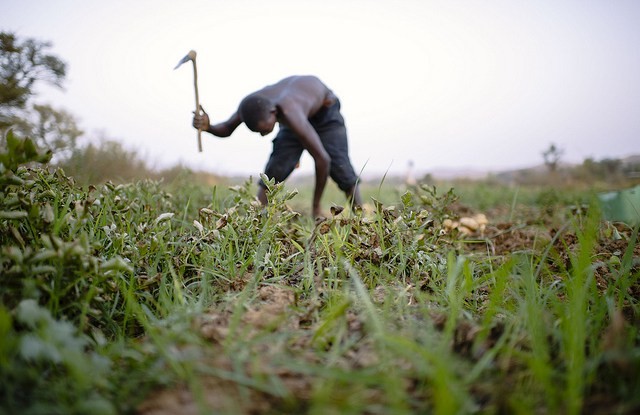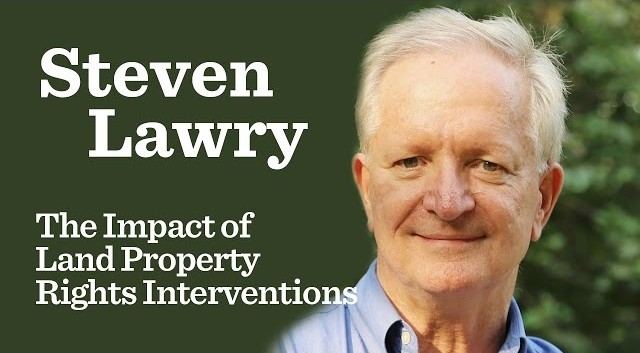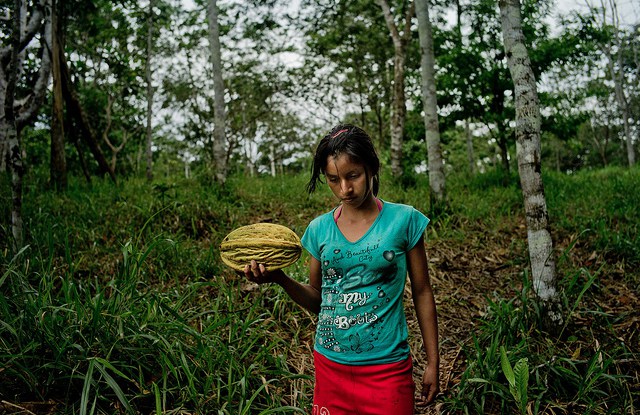
A lot of us who may come from the West assume that land rights certification, registration or titling are important attributes of any kind of land tenure or property rights system. We think of formal recording of land rights as essential to assuring farmers that they have land tenure security, an important enabling condition to agricultural development.
Economic theory and common sense tell us that if a family is going to invest in their property, they need to have a clear expectation that, far into the future, the kinds of sacrifices, investments of labor, capital, materials, into that land, and the benefits that come from those investments, will accrue to them. There’s a very simple relationship between land tenure security, property rights security, and investment: Theory predicts positive outcomes, and these are often observed practice, where people have clear tenure security.
However, in many developing countries, the kind of formal certification, property rights and titling systems that we are familiar with in wealthy countries often do not exist. A lot of farmers farm on land owned by the state. In Africa particularly, a lot of farming—up to 90 percent—is done on land held under customary tenure regimes, where land rights are not certified formally. Under customary tenure, people gain access to land as a social right, granted by virtue of their membership in a community.
THE QUESTION
So in 2013, the UK Department for International Development (DFID) asked me and a group of scholars to pull together a team of other researchers and graduate students to do a systematic review on the effects of efforts to “formalize” land rights through certification or titling on changes in agricultural investment and productivity in the developing world. Theory would predict that where farm land was previously unregistered, levels of investment and productivity would increase markedly after certification or titling.
Part of the development discourse over the past 30 to 40 years has been that African agriculture will not take off unless people have clear tenure security, and there’s an underlying assumption that this is delivered through land-rights certification or titling, as in Latin America and parts of Asia. So, in light of the fact that over the past 30 to 40 years there have been a number of efforts to convert non-formally tenured regimes into formally tenured regimes, based on certification by the state, the question that DFID asked us to look into was, What have been the effects with respect to the expected increases following land-rights certification and investment in productivity? In farmer incomes? In flow of credit?
That was the topic of our systematic review. Our inclusion criteria was limited to studies that were based on randomized control trials—randomized samples of farming households in an area that had received a treatment, which was, for example, land-rights certification, in comparison to a community where we were able to control all other factors apart from the fact that the community had not received land-rights certification. We wanted to look at, empirically, the effects of the certification intervention on investment, productivity of agriculture, farmer family incomes, and access to credit.
THE FINDINGS
Those who have conducted systematic reviews know the pain. The graduate students looked at 25,000 titles on this subject and reduced that to a review of 1,000 abstracts, which yielded 100 papers that we looked at in detail. Only 20 studies met our inclusion criteria. This is a huge question for the development world, for economic theory, a whole host of issues—and only 20 studies met a rigorous standard of empirical research design.
The 20 studies fell in nine countries: five in Latin America, five in Asia, and 10 in Africa.
In the Latin American and Asia cases, after certification or titling, there were significant gains to productivity of between 50 and 100 percent, and strongly positive gains to investment and income following tenure recognition, typically titling. However, in the Africa cases, there were weak or modest gains to productivity—between zero and 10 percent gains to productivity—and in investment and income following certification (though in most cases there were still positive gains).
Another important finding was there was no or weak discernible credit effects anywhere. Most studies—and we were looking very carefully through a gender lens with respect to differential effects on men and women—failed to aggregate effects of tenure recognition on women, except for two quantitative studies that identified positive effects (in Ethiopia and in Rwanda).
WHY DID RESULTS DIFFER?
So then the question becomes, Why are these significant gains in Latin America and Asia, and these relatively weak or modest gains in Africa? We have three hypotheses that we’re exploring through further research.
The first hypothesis is what we’re calling the role of pre-existing institutions—in Africa specifically, customary tenure. Customary tenure systems provide access to land as a social right by virtue of one’s membership in the community. An indicator of the security of the tenure is that land can often be inherited by other family members, but it can’t be sold, typically. Customary tenure often provides high levels of tenure security.
Customary tenure systems generally provide poor people in Africa access to land, free of charge, and once again as a social right; this is a pervasive institution in Africa. The designers of certification and titling programs, we hypothesized, were likely underestimating the tenure security of people who held those lands. And so when those land rights were certified, the kind of productivity gains or investment gains that would have been projected, assuming prior tenure insecurity, didn’t happen. Those assumptions were misplaced.
Another factor is what we’re calling the wealth effect: Household resources and income in Africa are much lower among poor farmers in comparison to poor farmers in Latin America and in Asia. So, if you’re going to do something with your land, it’s just not about land as an asset. It’s about labor, capital, having the income to invest in your farming enterprise, and the generally low levels of income among African farmers constrain their ability to make better use of their land. That’s hypothesis number two.
The third hypothesis is what we’re calling the effects of complementary public investments. Programs to secure land rights are best treated as one element in comprehensive agrarian reform programs. Effective reform is not about providing secure land rights to people. It’s also about providing affordable access to farming inputs and markets, and investment in roads, cooperatives, farming training, and so on; investments that enable farmers to capitalize on their secure land rights. Levels of public investment in rural areas in Africa are, we believe, much lower than they are in Latin America and Asia.
One of our arguments is that, when talking about land-rights certification or formalization in Africa, you really have to approach it as a package of investments, and you have to account for this wealth effect.
Our plan is to explore more deeply what might explain the weaker responses in Africa. We believe the hypotheses I’ve noted provide a good starting point.
Steven Lawry is director of forests and governance research at CIFOR. For more information about the topics of this article, contact him at s.lawry@cgiar.org.
CIFOR’s research on land tenure forms part of the CGIAR Research Program on Forests, Trees and Agroforestry.
We want you to share Forests News content, which is licensed under Creative Commons Attribution-NonCommercial-ShareAlike 4.0 International (CC BY-NC-SA 4.0). This means you are free to redistribute our material for non-commercial purposes. All we ask is that you give Forests News appropriate credit and link to the original Forests News content, indicate if changes were made, and distribute your contributions under the same Creative Commons license. You must notify Forests News if you repost, reprint or reuse our materials by contacting forestsnews@cifor-icraf.org.

